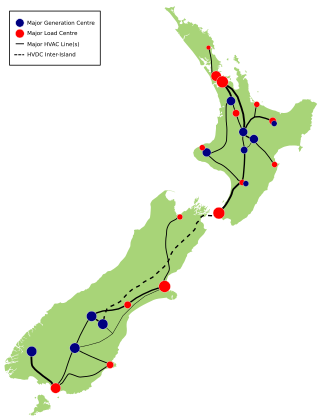The New Zealand electricity market (NZEM) is a decentralised electricity market regulated by the Electricity Industry Participation Code administered by the Electricity Authority (EA). The authority was established in November 2010 to replace the Electricity Commission.

Genesis Energy Limited, formerly Genesis Power Limited is a New Zealand publicly listed electricity generation and electricity, natural gas and LPG retailing company. It was formed as part of the 1998–99 reform of the New Zealand electricity sector, taking its generation capacity from the breakup of the Electricity Corporation of New Zealand (ECNZ) and taking retail customers from three local power boards in the Lower North Island. The New Zealand Government owns a 51% share of the company.
Transpower New Zealand Limited (TPNZ) is the state-owned enterprise responsible for electric power transmission in New Zealand. It performs two major functions in the New Zealand electricity market. As the owner of the National Grid it provides the infrastructure of electric power transmission that allows consumers to have access to generation from a wide range of sources, and enables competition in the wholesale electricity market; as system operator it manages the real-time operation of the grid and the physical operation of the electricity market.
Meridian Energy Limited is a New Zealand electricity generator and retailer. The company generates the largest proportion of New Zealand's electricity, generating 35 percent of the country's electricity in the year ending December 2014, and is the fourth largest retailer, with 14 percent of market share in terms of customers as of December 2015.
The HVDC Inter-Island link is a 610 km (380 mi) long, 1200 MW high-voltage direct current (HVDC) transmission system connecting the electricity networks of the North Island and South Island of New Zealand together. It is commonly referred to as the Cook Strait cable in the media and in press releases, although the link is much longer than its Cook Strait section. The link is owned and operated by state-owned transmission company Transpower New Zealand.

Mercury NZ Limited is a New Zealand electricity generation and multi-product utility retailer of electricity, gas, broadband and mobile telephone services. All the company's electricity generation is renewable. Mercury has a pre-paid electricity product sub-brand GLOBUG. Mercury Energy is also the largest electricity retailer in New Zealand.

The Huntly Power Station is the largest thermal power station in New Zealand and is located in the town of Huntly in the Waikato. It is operated by Genesis Energy Limited, a publicly listed company. The station has five operational generating units – three 250 MW coal-and-gas-fired steam turbine units, a 50 MW gas peaking plant, and a 403 MW combined cycle gas turbine plant. The station also plays an important role in voltage support for the Northland, Auckland and Waikato regions.

Contact Energy Limited is a New Zealand electricity generator, a wholesaler of natural gas, and a retailer of electricity, natural gas, broadband and LPG.
The electricity sector in New Zealand uses mainly renewable energy, such as hydropower, geothermal power and increasingly wind energy. As of 2021, the country generated 81.2% of its electricity from renewable sources. The strategy of electrification is being pursued to enhance the penetration of renewable energy sources and to reduce greenhouse gas (GHG) emissions across all sectors of the economy. In 2021, electricity consumption reached 40 Terawatt-hours (TWh), representing a 0.2% increase compared to the consumption levels in 2010.

The New Plymouth Power Station (NPPS) was a 600 MW thermal power station at New Plymouth, New Zealand. Located at Port Taranaki, it was dual fuelled on natural gas and fuel oil. Constructed at a time of major hydro and HV transmission developments, it was New Zealand's first big thermal power station planned for continuous base load operation.
The Stratford Power Station is a 577 MW power station located east of Stratford, in Taranaki, New Zealand. The original power station on the site was a 200 MW gas turbine power plant that opened in 1976 and closed in 2001. The current power station comprises a 377 MW combined cycle unit that opened in 1998 and two open cycle gas turbine units for peaking power that opened in 2011. The station is now owned and operated by Contact Energy.

The Wairakei Power Station is a geothermal power station near the Wairakei Geothermal Field in New Zealand. Wairakei lies in the Taupō Volcanic Zone.
The Poihipi Power Station is a geothermal power station owned and operated by Contact Energy. It is located on Poihipi Road near Taupō in New Zealand.

The Coleridge Power Station is a hydroelectric facility at Lake Coleridge on the Rakaia River in Canterbury, New Zealand. The power station is owned and operated by Manawa Energy.

The National Grid is the nationwide system of electric power transmission in New Zealand. The grid is owned, operated and maintained by Transpower New Zealand, a state-owned enterprise, although some lines are owned by local distribution companies and leased to Transpower. In total, the national grid contains 11,803 kilometres (7,334 mi) of high-voltage lines and 178 substations.

The Whakamaru to Brownhill Road transmission line is a double-circuit 400 kV-capable transmission line constructed by Transpower to increase the capacity of the National Grid between the southern Waikato and the city of Auckland. The line runs from the Whakamaru sub-station near the Whakamaru Power Station, over a distance of 186 kilometres (116 mi) to the new Brownhill Road substation near Whitford in southeastern Auckland. The line will initially be operated at 220 kV. From Brownhill Road, 220 kV underground cables connect the line to the Pakuranga sub-station in eastern Auckland. The project was the subject of considerable controversy and protest during the planning and approval stages. Construction of the line started in February 2010, and the line was commissioned on 30 October 2012. The transmission line forms the major part of a wider North Island Grid Upgrade project with a forecast cost to completion of $894 million.

WEL Networks Limited is an electricity distribution company, serving the northern and central Waikato region of New Zealand. WEL is the sixth largest electricity distribution company in New Zealand, with 100,142 connections and 7,021 km (4,363 mi) of lines and underground cables. The company is 100% owned by the WEL Energy Trust.
MainPower New Zealand Limited is an electricity distribution company, based in Rangiora, New Zealand, responsible for electricity distribution to nearly 42,000 customers in the Canterbury region north of the Waimakariri River. MainPower was formed in 1993, after the Energy Companies Act 1992 required the North Canterbury Electric Power Board to reform into a commercial power company. More reforms in 1998 required electricity companies nationally to split their lines and retail businesses, with MainPower retaining its lines business and selling its retail business to Contact Energy.
Northpower Limited (Northpower) is an electricity distribution company, based in Whangārei, New Zealand.









